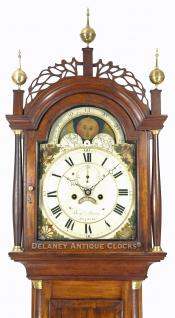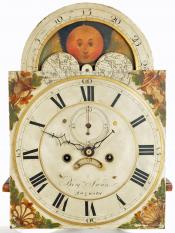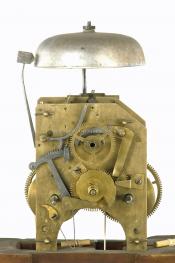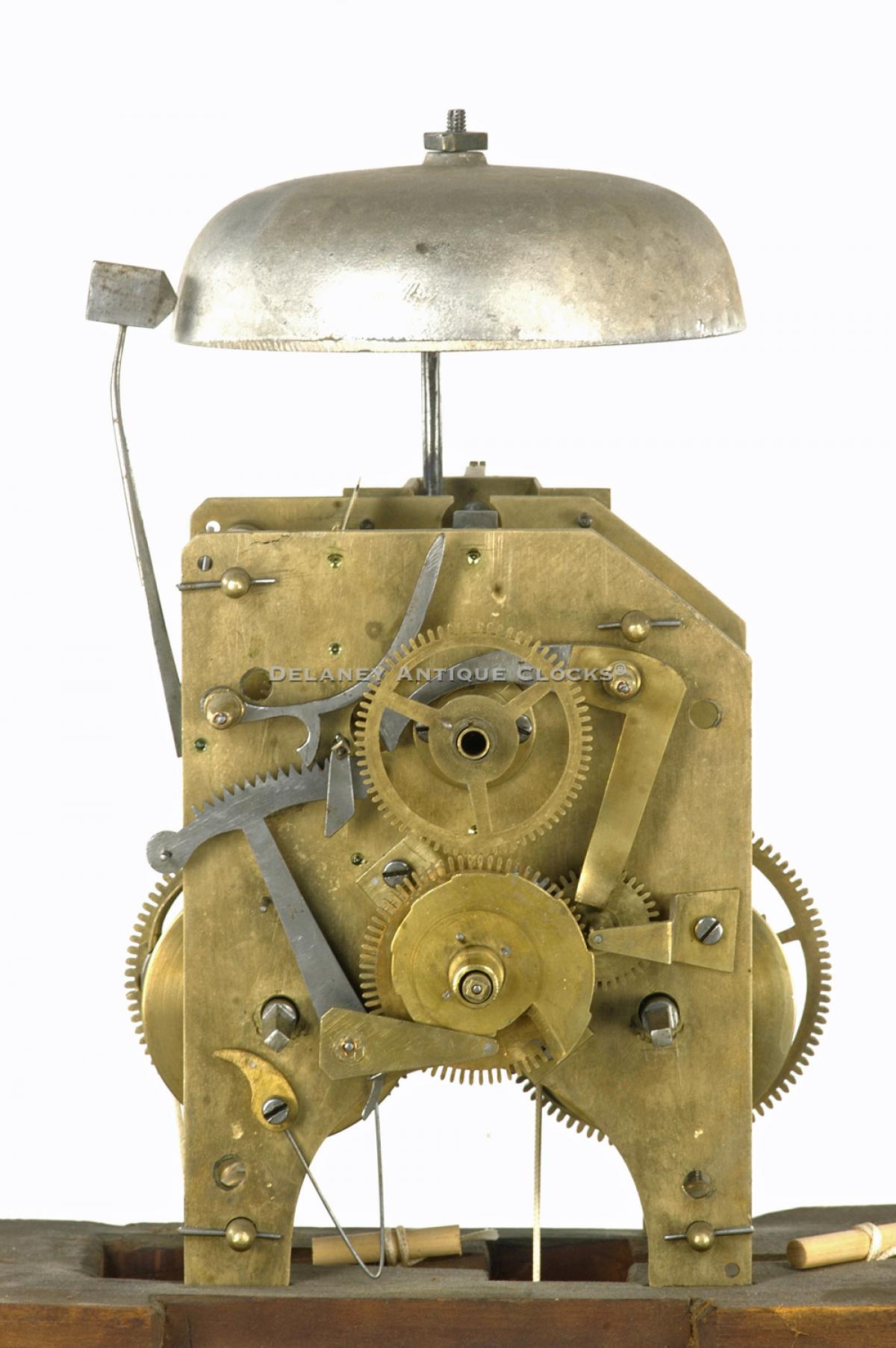Benjamin Swan of Augusta, Maine. A mahogany cased tall clock. UU-54.
A most beautiful tall case clock made by the Augusta, Maine clockmaker, Benjamin Swan. Swan worked as a clockmaker, watchmaker & jeweler in the towns of Hallowell and Augusta, Maine.
Benjamin Swan was born in Haverhill, Massachusetts, on January 15, 1792, the son of Francis and Abigail (Eliot) Swan. Sometime in 1808, the Swan family moved from Haverhill to Augusta, Maine. Previously, a number of Haverhill residents had made this same move. One of which was Frederic Wingate, who had established a clock business in that town as early as 1803. It is Wingate who is thought to have trained Benjamin Swan in the art of clock making. Benjamin worked both in Augusta and the town of Hallowell as a clockmaker, a silversmith, and a jeweler from 1814 through 1867. During the War of 1812, Benjamin served in the military as a Sergeant and was stationed in Wiscasset. He also married Hannah Smith of Hallowell. They had ten children. Benjamin Swan died in Augusta on November 27, 1867. Tall case clocks, Massachusetts shelf clocks, banjo clocks, and mirror clocks are known.
We have owned a fair number of clocks made by this Maker. This is one of the more formal examples exhibiting excellent proportions and constructed in mahogany wood.
This fine formal mahogany case exhibits the traditional Augusta form and proportions. The fact that it is constructed in mahogany is unusual. The typical case woods used in furniture construction in this northern New England region are typically indigenous and include birch, maples, and cherry. The use of mahogany suggests that this example must have been a special order. This case has been recently refinished. This modern shellac-based finish promotes the natural color of the wood and highlights its grain patterns.
This example stands tall on a cut-out bracket base. The feet have very good height and flow into a nicely developed apron. The lower molding is a simple design and is applied to three sides of the base section. The front surface of the base is fitted with an inset panel trimmed with a molded edge. The waist section is long and narrow and features a rectangular waist door. This door provides access to the two drive weights and the brass-faced pendulum bob located inside the case. This waist door is formatted with a broad mahogany cross-banded border. This frames the lighter bird's-eye maple panel. Quarter columns are set into the corners of the waist. These are decorated with multiple ring turnings and terminate in brass quarter capitals. The arched bonnet is fitted with a pierced and open fretwork pattern. This pattern is a traditional Augusta form and has been seen on numerous other examples. The three finial plinths support the brass ball and spike finials. The bonnet columns are turned and end in brass capitals. They flank the arched bonnet door, which is fitted with glass and opens to a colorfully painted dial of Boston origin.
This colorfully painted dial features a moon phase or lunar calendar in the arch. The four spandrel areas are decorated with seashells. A gilt circle frames the time ring. Roman-style numerals mark each of the hours. Arabic numerals are used to indicate the quarter hours only. The dial's interior features a subsidiary seconds dial and a calendar dial. The Maker also signs this clock in this general location. The signature is written in a lovely script format. After viewing this, one could easily argue that Benjamin Swan was very proud of his this clock. The working location of "Augusta" is printed in smaller block lettering.
This movement is constructed in brass and is of good quality. It is weight-driven and designed to run for eight days on a full wind. It is a time and strike design having a rack and snail striking system. As a result, it will strike each hour on the hour. This is done on a cast iron bell mounted above the movement.
This clock was made circa 1810. It stands 7 feet 9 inches tall.
Inventory number UU-54.
Benjamin Swan, the son of Francis and Abigail (Eliot) Swan, was born in Haverhill, Massachusetts, on January 15, 1792. Sometime in 1808, the Swan family moved from Haverhill to Augusta, Maine. Previously, a number of Haverhill residents had made this same move. One of which was Frederic Wingate, who had established a clock business in that town as early as 1803. It is Wingate who is thought to have trained Benjamin Swan in the art of clock making. Benjamin worked both in Augusta and the town of Hallowell as a clockmaker, a silversmith, and a jeweler from 1814 through 1867. During the War of 1812, he served as a Sergeant stationed in Wiscasset. In this year, he also marries Hannah Smith of Hallowell. They had ten children. One of which, Moses Moody Swan, worked with his father in about 1818. Benjamin Swan died in Augusta on November 27, 1867. Tall case clocks, Massachusetts shelf clocks, banjo clocks, and mirror clocks are known to us. In addition, a watch is known that is signed B & MM Swan. This is a product of Benjamin and his son Moses Moody.
We have owned a fair number of clocks made by this maker. This is one of the more desirable examples in that it features a dial with an automated rocking ship in the arch.










